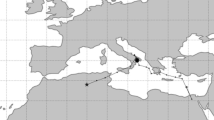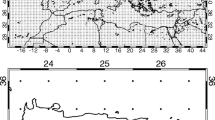Abstract
An attempt is made to explore the vertical structure of the surface explosive cyclones in the Mediterranean on a climatological basis during the cold period of the year in order to get a better insight in the interaction between the upper and lower levels responsible for the genesis and evolvement of the phenomenon. The vertical profile of the explosive cyclones was examined with the aid of the vertical tracing software of the University of Melbourne Cyclone Tracking Algorithm, using the 1 × 1° spatial resolution of ERA-40 reanalysis data. It was found that about 57 % of the track steps of surface explosive cyclones extend up to 500 hPa. The north-westward tilting of the surface cyclones with height during the stage of explosive cyclogenesis, with a mean distance of 350 km between mean sea and 500 hPa levels, confirms the importance of baroclinicity. About 45 % of the surface explosive cyclones reached their maximum depth before their 500 hPa counterparts, implying the role of surface processes.















Similar content being viewed by others
References
Allen JT, Pezza AB, Black MT (2010) Explosive cyclogenesis: a global climatology comparing multiple reanalysis. J Clim 23:6468–6484. doi:10.1175/2010JCLI3437.1
Alpert P, Neeman U, Shay-El Y (1990a) Climatological analysis of the Mediterranean cyclones using ECMWF data. Tellus 42A:65–77. doi:10.1034/j.1600-0870.1990.00007.x
Alpert P, Neeman BU, Shay-El Y (1990b) Intermonthly variability of cyclone tracks in the Mediterranean. J Clim 3:1474–1478. doi:10.1175/1520-0442
Anagnostopoulou C, Tolika K, Flocas H, Maheras P (2006) Cyclones in the Mediterranean region: present and future climate scenarios derived from a general circulation model (HadAM3P). Adv Geosci 7:9–14
Bartholy J, Pongrácz R, Pattantyús-Ábrahám M (2009) Analyzing the genesis, intensity, and tracks of western Mediterranean cyclones. Theor Appl Climatol 96:133–144. doi:10.1007/s00704-008-0082-9
Bengtsson L, Hodges KI, Keenlyside N (2009) Will extra-tropical storms intensify in a warmer climate? J Clim 22:2276–2301. doi:10.1175/2008JCLI2678.1
Campins J, Jansà A, Genovés A (2006) Three-dimensional structure of Western Mediterranean cyclones. Int J Climatol 26:323–343. doi:10.1002/joc.1275
Campins J, Genovés A, Picornell MA, Jansà A (2011) Climatology of Mediterranean cyclones using the ERA-40 dataset. Int J Climatol 31:1596–1614. doi:10.1002/joc.2183
Capaldo M, Conte M, Finizio C, Todisco G (1980) A detailed analysis of a severe storm in the central Mediterranean: the case of the Trapani flood. Riv Meteorol Aeronaut v.XL, n.2-3
Colucci SJ (1985) Explosive cyclogenesis and large scale circulation changes: implications for atmospheric blocking. J Atmos Sci 42:2701–2717. doi:10.1175/1520-0469
Conte M (1986) The meteorological “bomb” in the Mediterranean: a synoptic climatology. Riv Meteorol Aeronaut 46:121–130
Conte M, Piervitali E, Colacino M (1997) The meteorological bomb in the Mediterranean. INM/WMO international symposium on cyclones and hazardous weather in the Mediterranean. MMA/UIB:283-287.
Courtier P, Andersson E, Heckley W, Vasiljevic D, Hamrud M, Hollingsworth A, Rabier F, Fisher M, Pailleux J (1998) The ECMWF implementation of three dimensional variational assimilation 3D-Var. Part I: formulation. Q J R Meteorol Soc 124:1783–1808. doi:10.1002/qj.49712455002
Flocas HA, Maheras P, Karacostas TS, Patrikas I, Anagnostopoulou C (2001) A 40-year climatological study of relative vorticity distribution over the Mediterranean. Int J Climatol 21:1759–1778. doi:10.1002/joc.705
Flocas HA, Simmonds I, Kouroutzoglou J, Kevin K, Hatzaki M, Bricolas V, Asimakopoulos D (2010) On cyclonic tracks over the eastern Mediterranean. J Clim 23:5243–5257. doi:10.1175/2010Jcli3426.1
Genovés A, Jansà A (1991) The use of potential vorticity maps in monitoring shallow and deep cyclogenesis in the Western Mediterranean. WMO/TD num 420:55–65
Genovés A, Campins J, Jansà A (2006) Intense storms in the Mediterranean: a first description from the ERA-40 perspective. Adv Geosci 7:163–168
Gyakum JR, Danielson RE (2000) Analysis of meteorological precursors to ordinary and explosive cyclogenesis in the Western North Pacific. Mon Weather Rev 128:851–863. doi:10.1175/1520-0493
Gyakum JR, Roebber PJ, Bullock TA (1992) The role of antecedent surface vorticity development as conditioning process in explosive cyclone intensification. Mon Weather Rev 120:1465–1489. doi:10.1175/1520-0493(1992)120<1465:TROASV>2.0.CO;2
HMSO (1962) Weather in the Mediterranean, vol 1, 2nd edn. Meteorological Office.
Homar V, Jansà A, Campins J, Ramis C (2006) Towards a climatology of sensitivities of Mediterranean high impact weather—first approach. Adv Geosci 7:259–267. doi:10.5194/adgeo-7-259-2006
Karacostas TS, Flocas AA (1983) The development of the “bomb” over the Mediterranean area. La Meteorologie, Actes de la conference “eau verte” 34:351-358.
Karein AD (1979) The forecasting of cyclogenesis in the Mediterranean region. Dissertation, University of Edinburgh.
Keable M, Simmonds I, Keay K (2002) Distribution and temporal variability of 500 hPa cyclone characteristics in the Southern Hemisphere. Int J Clim 22:131–150. doi:10.1002/joc.728
Konrad CE, Colucci SJ (1988) Synoptic climatology of 500 mb circulation changes during explosive cyclogenesis. Mon Weather Rev 116:1431–1443. doi:10.1175/1520-0493
Kouroutzoglou J, Flocas HA, Simmonds I, Keay K, Hatzaki M (2011a) Climatological aspects of explosive cyclones in the Mediterranean. Int J Climatol 31:1785–1802. doi:10.1002/joc.2203
Kouroutzoglou J, Flocas HA, Simmonds I, Keay K, Hatzaki M (2011b) Assessing characteristics of Mediterranean explosive cyclones for different data resolution. Theor Appl Climatol 105:263–275. doi:10.1007/s00704-010-0390-8
Krichak SO, Alpert P, Bassat K, Kunin P (2007) The surface climatology of the eastern Mediterranean region obtained in a three-member ensemble climate change simulation experiment. Adv Geosci 12:67–80. doi:10.5194/adgeo-12-67-2007
Lagouvardos K, Kotroni V, Defer E (2006) Synoptic environment related to rapid cyclogenesis in the Eastern Mediterranean. Adv Geosci 7:115–119. doi:10.5194/adgeo-7-115-2006
Leonard SR, Turner J, Van Der Wal A (1999) An assessment of three automatic depression tracking schemes. Meteorol Appl 6:173–183. doi:10.1017/S135048279900119X
Lim EP, Simmonds I (2002) Explosive cyclone development in the Southern Hemisphere and a comparison with Northern Hemisphere events. Mon Weather Rev 130:2188–2209. doi:10.1175/1520-0493
Lim EP, Simmonds I (2007) Southern hemisphere winter extratropical cyclone characteristics and vertical organization observed with the ERA-40 data in 1979–2001. J Clim 20:2675–2690. doi:10.1175/JCLI4135.1
Lionello P, Dalan F, Elvini E (2002) Cyclones in the Mediterranean region: the present and the doubled CO2 climate scenarios. Clim Res 22:147–159. doi:10.3354/cr022147
Lolis CJ, Bartzokas A, Katsoulis BD (2004) Relation between sensible and latent heat fluxes in the Mediterranean and precipitation in the Greek area during winter. Int J Clim 24:1803–1816. doi:10.1002/joc.1112
Maheras P, Flocas HA, Patricas I, Anagnostopoulou C (2001) A 40 year objective climatology of surface cyclones in the Mediterranean region: spatial and temporal distribution. Int J Climatol 21:109–130. doi:10.1002/joc.599
Maheras P, Flocas HA, Anagnostopoulou C, Patrikas I (2002) On the vertical structure of composite surface cyclones in the Mediterranean region. Theor Appl Climatol 71:199–217. doi:10.1007/s007040200005
Mesquita MDS, Atkinson DE, Simmonds I, Keay K, Gottschalck J (2009) New perspectives on the synoptic development of the severe October 1992 Nome storm. Geophys Res Lett 36:L13808. doi:10.1029/2009GL038824
Murray RJ, Simmonds I (1991a) A numerical scheme for tracking cyclone centres from digital data. Part I: development and operation of the scheme. Aust Meteorol Mag 39:155–166
Murray RJ, Simmonds I (1991b) A numerical scheme for tracking cyclone centres from digital data. Part II: application to January and July general circulation model simulations. Aust Meteorol Mag 39:167–180
Nielsen-Gammon JW (1995) Dynamical conceptual models of upper-level mobile trough formation: comparison and application. Tellus 47A:705–721. doi:10.1034/j.1600-0870.1995.00114.x
Petterssen S (1956) Motion and motion systems, vol. 1. Weather analysis and forecasting, 2nd edn. McGraw-Hill, New York
Pinto JG, Spangehl T, Ulbrich U, Speth P (2005) Sensitivities of a cyclone detection and tracking algorithm: individual tracks and climatology. Meteor Z 14:823–838. doi:10.1127/0941-2948/2005/0068
Prezerakos NG, Flocas HA (1996) The formation of a dynamically unstable ridge at 500 hPa as a precursor of surface cyclogenesis in the central Mediterranean. Meteorol Appl 3:101–111. doi:10.1002/met.5060030201
Prezerakos NG, Flocas HA, Michaelides SC (1999) Upper tropospheric downstream development leading to surface cyclogenesis in the central Mediterranean. Meteorol Appl 6:1–10. doi:10.1017/S1350482799001218
Radinovic D (1987) Mediterranean cyclones and their influence on weather and climate. WMO, PSMP Rep. Ser. num 24
Raible CC, Della-Marta PM, Schwierz C, Wernli H, Blender R (2008) Northern Hemisphere extratropical cyclones: a comparison of detection and tracking methods and different reanalyses. Mon Weather Rev 136:880–897. doi:10.1175/2007MWR2143.1
Raible CC, Ziv B, Saaroni H, Wild M (2010) Winter synoptic-scale variability over the Mediterranean Basin under future climate conditions as simulated by the ECHAM5. Clim Dyn 35(2–3):473–488. doi:10.1007/s00382-009-0678-5
Sanders F (1986) Explosive cyclogenesis in the West-Central North Atlantic Ocean, 1981-84. Part I: composite structure and mean behavior. Mon Weather Rev 114:1781–1794. doi:10.1175/1520-0493
Sanders F, Gyakum JR (1980) Synoptic–dynamic climatology of the “bomb”. Mon Weather Rev 108:1589–1606. doi:10.1175/1520-0493
Shay-El Y, Alpert P (1991) A diagnostic study of winter diabatic heating in the Mediterranean in relation to cyclones. Q J R Meteorol Soc 117:715–747. doi:10.1256/smsqj.50003
Simmonds I, Keay K (2000) Mean Southern Hemisphere extratropical cyclone behavior in the 40-year NCEP-NCAR reanalysis. J Clim 13:873–885. doi:10.1175/1520-0442
Simmonds I, Keay K (2009) Extraordinary September Arctic sea ice reductions and their relationships with storm behavior over 1979–2008. Geophys Res Lett 39:L9715. doi:10.1029/2009GL039810
Simmonds I, Murray RJ (1999) Southern extratropical cyclone behavior in ECMWF analyses during the FROST special observing periods. Weather Forecast 14:878–891. doi:10.1175/1520-0434
Simmonds I, Murray RJ, Leighton RM (1999) A refinement of cyclone tracking methods with data from FROST. Aust Meteorol Mag, Special Ed 35-49
Speranza A, Buzzi A, Trevisan A, Malguzzi P (1985) A theory of deep cyclogenesis in the lee of the Alps. Part 1: modifications of baroclinic instability by localized topography. J Atmos Sci 42:1521–1535. doi:10.1175/1520-0469(1986)043<2826:ATODCI>2.0.CO;2
Sutcliffe RC (1960) Depression, front and air mass modification in the Mediterranean. UNESCO/WMO seminar on Mediterranean synoptic meteorology. Meteorologische Abhandlungen Band IX: 13–143
Trigo IF, Davies TD, Bigg GR (1999) Objective climatology of cyclones in the Mediterranean region. J Clim 12:1685–1696. doi:10.1175/1520-0442
Trigo IF, Bigg GR, Davies TD (2002) Climatology of cyclogenesis mechanisms in the Mediterranean. Mon Weather Rev 130:549–569. doi:10.1175/1520-0493
Uccellini LW (1986) The possible influence of upstream upper-level baroclinic processes on the development of the QE II Storm. Mon Weather Rev 114:1019–1027. doi:10.1175/1520-0493(1986)114<1019:TPIOUU>2.0.CO;2
Uppala SM et al (2005) The ERA-40 re-analysis. Q J R Meteorol Soc 131:2961–3012. doi:10.1256/qj.04.176
Wang CC, Rogers JC (2001) A composite study of explosive cyclogenesis in different sectors of the North Atlantic. Part I: cyclone structure and evolution. Mon Weather Rev 129:1481–1499. doi:10.1175/1520-0493
Author information
Authors and Affiliations
Corresponding author
Appendix
Appendix
Rights and permissions
About this article
Cite this article
Kouroutzoglou, J., Flocas, H.A., Keay, K. et al. On the vertical structure of Mediterranean explosive cyclones. Theor Appl Climatol 110, 155–176 (2012). https://doi.org/10.1007/s00704-012-0620-3
Received:
Accepted:
Published:
Issue Date:
DOI: https://doi.org/10.1007/s00704-012-0620-3




